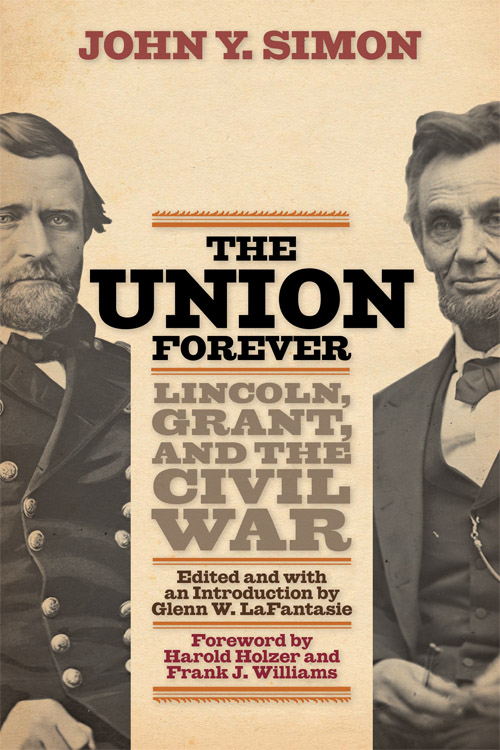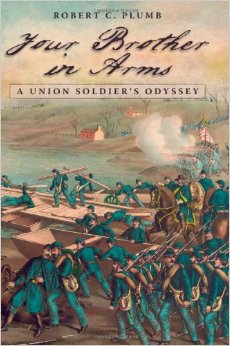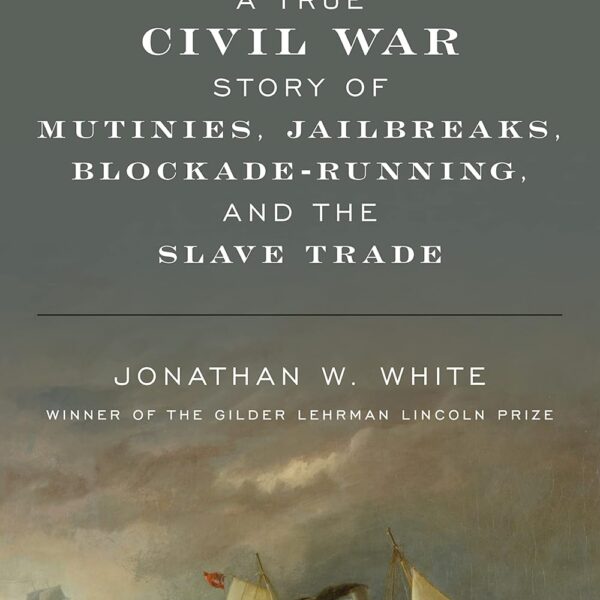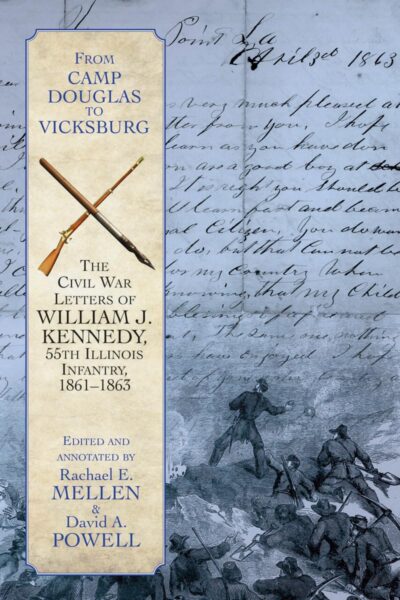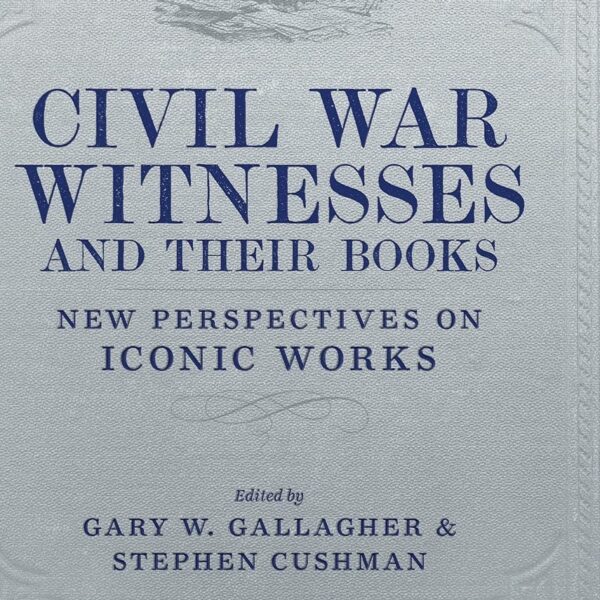We are currently in the midst of a U.S. Grant renaissance. Recent studies by Brooks Simpson, Jean Smith, Joan Waugh and H.W. Brands have sought to rehabilitate the reputation of a man too often dismissed as a drunken butcher during the Civil War and afterwards as one of the most corrupt, incompetent presidents in history. As Glenn LaFantasie suggests in his introductory essay on the life and scholarly accomplishments of the late John Y. Simon, no person is more responsible for making this reassessment of Grant possible than Simon. From its inception during the Civil War Centennial until his death in 2008, Simon served as executive director and managing editor of The Papers of Ulysses S. Grant. Under Simon’s expert leadership, thirty-one volumes of Grant’s papers were published. Sadly, Simon’s death prevented him from completing the final tasks of the project—a scholarly edition of Grant’s Memoirs and supplemental volume of correspondence. Fortunately, these remaining volumes will be completed under the direction of John F. Marszalek. The Papers of Ulysses S. Grant is a towering achievement in the field of documentary editing and an enduring testament to Simon’s contribution to our knowledge of the Civil War Era that will remain both a definitive and indispensable resource. The essays in The Union Forever provide ample evidence that in addition to being a great editor, Simon also produced some very perceptive pieces on Abraham Lincoln, Grant, and their partnership during the war.
LaFantasie selected fifteen of the most important and historiographically significant essays that Simon wrote during his long and productive career. All of the essays were previously published, but The Union Forever conveniently collects them in a single volume that includes an extensive bibliography of Simon’s work and an essay by LaFantasie that discusses Simon’s professional career and provides personal reminiscences that effectively capture his personality. Those who had the pleasure of meeting Professor Simon will likely find themselves smiling and nodding in agreement as they read LaFantasie’s descriptions of Simon’s talent as a public speaker, his sense of humor, commitment to his profession, and willingness to assist other scholars.
While one would naturally expect the editor of Grant’s papers to be able to offer some insights into Grant’s career, personality, and legacy, the first part of the collection consists of seven essays on Lincoln, which evince a keen and wide-ranging understanding of Grant’s commander-in-chief. In a perceptive piece that analyzes Lincoln’s fear during August 1864, that he would lose the presidential election, Simon examines the incomplete evidence concerning what contingency plans Lincoln may have pursued to save the Union prior to the inauguration of his successor in 1865 and forthrightly observes: “Does anyone really know Lincoln? Can anyone follow his thought to the point of predicting policy? This wondrously unique statesman continually frustrates such efforts” (99). Simon’s command of the available sources led him to this frank realization, yet such was not the case with what he humorously terms “[c]uckoos in the Lincoln nest” who were “supremely confident that they alone are the rightful inhabitants”(101). In an article first published in 1966, Simon details the efforts that two of these “cuckoos,” Ward Hill Lamon and Dennis Hanks, made in order to curry favor with Andrew Johnson’s administration. While Lamon and Hanks had known Lincoln, in 1866 they claimed intimate knowledge of the martyred president that enabled them to predict the course of policy Lincoln would have pursued if he had lived. Both Hanks and Lamon published public letters addressed to Johnson, which asserted that Lincoln would have found himself in conflict with Radical Republicans while pursuing a Reconstruction policy not unlike Johnson’s. Though Simon laments that interest in a “historical Lincoln” as opposed to “one with a partisan usefulness” may have resulted in the “truth” being “buried forever,” he was in the vanguard of Lincoln scholars in the early 1990s that revisited the story of Lincoln’s alleged relationship with Ann Rutledge. Long dismissed as a myth conceived by William H. Herndon and advanced by those who preferred a romantic image of Lincoln rather than one based on evidence, Simon concluded in 1990 that Lincoln loved Rutledge and her death sent him into a severe episode of depression. While Simon was willing to accept the veracity of the Ann Rutledge story, he was not willing to go as far as Douglas Wilson, Rodney Davis, and Michael Burlingame in rehabilitating Herndon’s reputation. Simon’s 1987 McMurtry Lecture, which explores Lincoln’s difficult relationships with his father and stepbrother, further demonstrates Simon’s range by offering a thoughtful interpretation of how this original “house divided” influenced Lincoln.
Essays on Fort Sumter, the Emancipation Proclamation, and Lincoln’s relationship with General Henry W. Halleck illustrate Simon’s ability to re-examine old questions and propose bold new answers. Simon argues that it is “ridiculous” to claim that Lincoln “provoked or tricked the South into firing the first shot” (62). Instead, Simon suggests that Jefferson Davis reacted irrationally to Lincoln’s attempt to provision Fort Sumter and his order to fire upon the fort “began the war in a way that could not have provided Lincoln greater advantages” (58). By firing the first shot at the U.S. flag flying in Charleston Harbor, Davis enabled Lincoln to justify the war as one strictly over preservation of the Union and thereby garner critical support from many Northern Democrats and border slave states that did not secede. Simon concludes that starting the war in such a way was nothing less than “a fatal blow foreshadowing Confederate defeat” (60). Never one to mince words, Simon characterizes Lincoln’s appointment of Halleck as general in chief in July 1862 as “one of the most outstanding blunders of the Civil War,” yet he details how despite serious shortcomings, Halleck possessed a facility for administrative work and perhaps most importantly served as a lightning rod for controversy that drew some criticism away from Lincoln (77, 86).
Less persuasive is Simon’s interpretation of the Emancipation Proclamation, which he narrowly frames within the context of Lincoln’s struggles with more radical members of his party in Congress. For Simon, Lincoln’s proclamation was essentially forced upon him by the passage of the Second Confiscation Act. Hoping to “preempt” this “vindictive” piece of legislation, the Emancipation Proclamation was a “tactical move” that sought to “prevent further outcries from the radicals” (68, 76). Lincoln began to draft an emancipation proclamation prior to the passage of the Second Confiscation Act and Simon does not consider Lincoln’s failed efforts to convince the loyal slave states to adopt a plan for federally compensated emancipation prior to the issuance of his Preliminary Emancipation Proclamation. The radicalness of the Second Confiscation Act also seems questionable when compared to the Final Emancipation Proclamation. While the Confiscation Act freed those slaves that managed to escape rebel owners or had been abandoned by them, Lincoln’s proclamation promised freedom to all slaves in areas that remained in rebellion on January 1, 1863. The ultimate effectiveness of Lincoln’s proclamation depended on the fortunes of Union armies, yet its potential was more sweeping in its extent than the Second Confiscation Act.
Simon’s essays on Grant, as one would expect, reflect his expertise, mastery of the sources, and desire to offer a more accurate depiction of the general and president. As editor of Grant’s papers, Simon realized there was much more substance to Grant than Henry Adams or proponents of the Lost Cause had led many to believe. In essays first published in the 1980s, Simon laid the groundwork for a new appreciation of Grant. Simon points out that at the end of the nineteenth-century Lincoln and Grant had almost equal numbers of books published about them, yet as Lincoln’s reputation continued to soar, Grant’s declined as his presidency became a symbol of Gilded Age corruption and incompetence and his victories in the Civil War were seen simply as a result of his realization that he could defeat Lee by bludgeoning him with superior numbers and resources. Simon’s project revealed that Grant wrote a great deal more than previously assumed and he argues that Grant was a “master of words” whose reputation suffered in part due to Grant’s reluctance to defend himself (133). Simon asserts that while Grant desired reconciliation between North and South, as president he was not willing to sacrifice “wartime black allies” for this goal and therefore “enforced civil rights legislation; and attacked terrorist organizations such as the Ku Klux Klan” (129). In a cogent essay on Grant’s generalship, Simon swiftly dispatches many misconceptions. He persuasively argues that Grant was a strategist and not simply a heartless butcher of his men. Grant was willing to use African American soldiers, though he did so without much fanfare, and Simon notes that rebel policy on black troops led to the collapse of prisoner exchanges in 1864. Grant, according to Simon, did not like war but he accepted the grim realities of warfare. This “realism,” should not be mistaken for “callousness,” and Simon defends Grant’s strategy during his 1864 campaign in Virginia as one that sought to “take the nation to the end of the war in the shortest time and with the smallest loss of life” (188). If Grant had withdrawn back toward Washington following the Wilderness, Spotsylvania, or Cold Harbor, the war might have lasted even longer and at greater costs. As Simon suggests, Grant’s crossing of the James River took Lee by surprise and might have resulted in victory if William F. Smith had been able to take Petersburg before Lee was able to react.
In addition to essays on Grant’s generalship and reputation, LaFantasie includes an enlightening essay on the Grants’ marriage and also an article on the relationship between Grant and Elihu Washburne, a Republican congressman from Galena, Illinois, who provided vital political support for Grant’s Civil War military career. Simon’s efforts to rehabilitate Grant’s reputation as a general and president should not be mistaken for uncritical adulation, as evidenced by a significant piece on Grant’s notorious General Orders No. 11, which ordered the expulsion of all Jews from his military department on December 17, 1862. By late 1862, Grant was increasingly frustrated by the corrupt trading practices that were being conducted and Simon suggests that the general “fell prey to the pervasive anti-Semitism of the day” (173). Though Grant had countermanded an order from one of his subordinates that sought to expel all Jews from Holly Springs, Mississippi, just days prior to issuing General Orders No. 11, Simon argues that the arrival of Grant’s father, Jesse, was the final straw. Jesse Grant was often a source of embarrassment to his son and his interest in purchasing cotton for a Jewish firm in Cincinnati led the general to take out his frustrations on Jesse’s Jewish business associates. Following protests from Jewish leaders, Grant was directed to revoke his orders. There the matter rested until Grant ran for president in 1868. Questions from potential Jewish supporters prompted Grant to compose a letter in which he disavowed the order and claimed not to have any prejudice against a particular sect or race.
The third and final section of the collection consists of two essays that explore the partnership between Lincoln and Grant. The first examines the delicate situation in Kentucky at the outset of the war and illustrates how Grant’s deft maneuvering in occupying Columbus, Kentucky served to fulfill Lincoln’s goal of preventing his native state from joining the Confederacy. Simon speculates that if things had happened otherwise, the outcome of the war might have been different. LaFantasie appropriately concludes with a piece that considers the Lincoln-Grant relationship after Grant was given command of all the armies in 1864. Simon’s nuanced analysis demonstrates that Lincoln and Grant were not immediately friends. Considering Grant’s Democratic background and Lincoln’s problems with previous generals in the East, Simon states that Lincoln initially perceived Grant as “a potential political rival, as possibly another McClellan” (216). Despite these initial misgivings, the two men formed a solid working relationship in which it was made clear that Lincoln was the commander-in-chief. Lincoln, according to Simon, kept Grant on a “leash” but it was longer than those of previous commanders. Though Grant is often portrayed as a vigorous proponent of unconditional surrender, Simon convincingly argues that the failure of the Hampton Roads conference and Lincoln’s strong rebuke of Grant’s proposal to discuss a political settlement of the war with Lee, indicate that Lincoln was a stronger advocate of this policy. Lincoln and Grant spent little time together and the substance of their meetings is not well documented, yet Simon concludes that the two men “forged an effective partnership” that enabled Grant to succeed (231).
Thirty years ago, Simon accurately predicted that the effort to unearth and publish Grant’s writings would provide a new “scholarly frontier” for studying Grant (134). In reflecting on the centennial of Grant’s death, Simon observed that much like Lincoln, Grant “remains on the historical horizon, always in view but never clearly visible” (121). Through Simon’s tireless dedication, Grant has become a lot more visible and better understood as scholars benefit from The Papers of Ulysses S. Grant. This monumental project stands as Simon’s greatest achievement, yet The Union Forever demonstrates that Simon produced several quality essays that substantially add to our knowledge of Grant, Lincoln and the era in which they lived.
Matthew Norman is an Assistant Professor of History at the University of Cincinnati – Blue Ash College.
